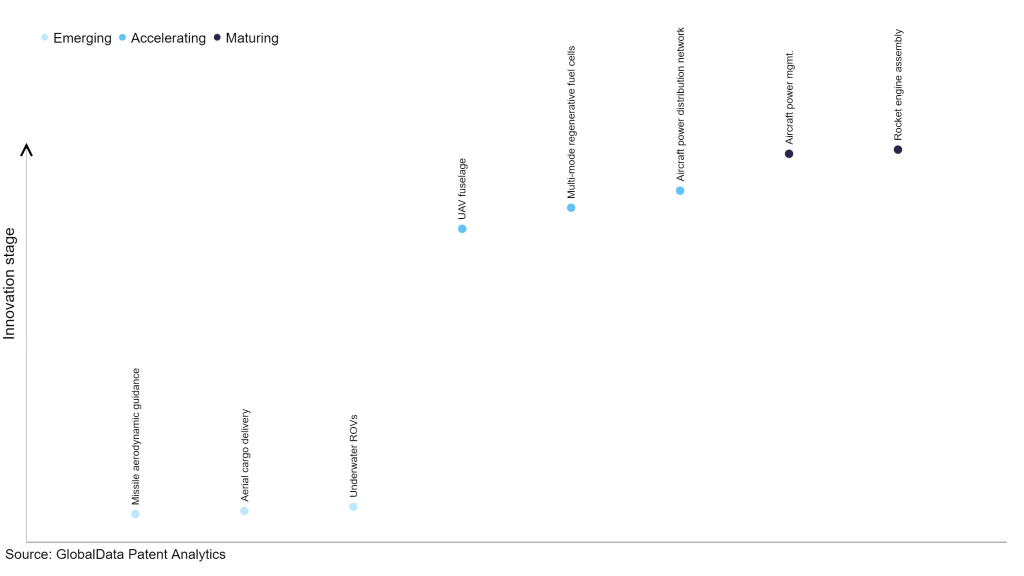The aerospace and defense industry continues to be a hotbed of patent innovation. Activity is driven by the pressing need for modernisation, and the growing importance of technologies such as artificial intelligence and unmanned systems. In the last three years alone, there have been over 84,000 patents filed and granted in the aerospace and defense industry, according to GlobalData’s report on Innovation in defense: galvano-scanners. Buy the report here.
However, not all innovations are equal and nor do they follow a constant upward trend. Instead, their evolution takes the form of an S-shaped curve that reflects their typical lifecycle from early emergence to accelerating adoption, before finally stabilizing and reaching maturity.
Identifying where a particular innovation is on this journey, especially those that are in the emerging and accelerating stages, is essential for understanding their current level of adoption and the likely future trajectory and impact they will have.
110 innovations will shape the aerospace and defense industry
According to GlobalData’s Technology Foresights, which plots the S-curve for the aerospace and defense industry using innovation intensity models built on over 260,000 patents, there are 110 innovation areas that will shape the future of the industry.
Within the emerging innovation stage, missile aerodynamic guidance, aerial cargo delivery, and underwater ROVs are disruptive technologies that are in the early stages of application and should be tracked closely. UAV fuselage, multi-mode regenerative fuel cells and aircraft power distribution network are some of the accelerating innovation areas, where adoption has been steadily increasing. Among maturing innovation areas are aircraft power management and rocket engine assembly, which are now well established in the industry.
Innovation S-curve for the aerospace and defense industry

Galvano-scanners is a key innovation area in aerospace and defense
Galvanometer optical scanners, also known as Galvos or Galvano-scanners, are critical components for laser beam directors and scanning technologies. Galvano scanners utilise motorised mirror mounts to rapidly and accurately re-direct small laser beams, and are thus crucial to a variety of technologies which rely on lasers for targeting and navigation, such as LiDAR sensors for unmanned vehicles.
GlobalData’s analysis also uncovers the companies at the forefront of each innovation area and assesses the potential reach and impact of their patenting activity across different applications and geographies. According to GlobalData, there are 80+ companies, spanning technology vendors, established aerospace and defense companies, and up-and-coming start-ups engaged in the development and application of galvano-scanners.
Key players in galvano-scanners – a disruptive innovation in the aerospace and defense industry
‘Application diversity’ measures the number of applications identified for each patent. It broadly splits companies into either ‘niche’ or ‘diversified’ innovators.
‘Geographic reach’ refers to the number of countries each patent is registered in. It reflects the breadth of geographic application intended, ranging from ‘global’ to ‘local’.
Patent volumes related to galvano-scanners
Source: GlobalData Patent Analytics
Apple is the global leader in terms of patent filing in galvano-scanner technology, as galvos are critical to the production of iPhone facial scanning technologies. Innoviz Technologies is the second most prolific patent filer over the last several years, with numerous applications involving novel galvano-scanner architectures for use in LiDAR sensors. Boeing and Raytheon Technologies are the two main players in this field specific to the defense industry, with both firms researching methods of optimizing galvano-scanners for applications in a range of vehicle or weapons guidance systems. Some other key patent filers in the automotive industry include Innoviz Technologies, Kyocera, Alphabet, Pioneer, and Ouster.
In terms of application diversity, Innoviz Technologies has published the most diverse range of patent applications, followed by Kyocera in second place and Ouster ranking third globally. By geographic reach, Ouster holds the top position, followed by Innoviz Technologies and Aurora Innovation.
As LiDAR technology continues to gain traction due to its applications in the unmanned or autonomous systems domain, demand for galvano-scanners is set to increase within the aerospace and defense industry, as well as other industries such as the automotive and technology markets due to the technical overlap. This rising demand could provide the catalyst for increased investment from defense firms active in associated markets such as unmanned systems or directed energy weapons development. The modernization of dismounted soldier systems increasingly involves the integration of emerging capabilities such as drones and laser targeting systems, thus expertise in the design and manufacture of galvano-scanners will prove valuable over the coming decades.
To further understand the key themes and technologies disrupting the aerospace and defense industry, access GlobalData’s latest thematic research report on Aerospace & Defense.
Data Insights
From

The gold standard of business intelligence.
Blending expert knowledge with cutting-edge technology, GlobalData’s unrivalled proprietary data will enable you to decode what’s happening in your market. You can make better informed decisions and gain a future-proof advantage over your competitors.



